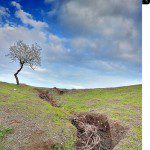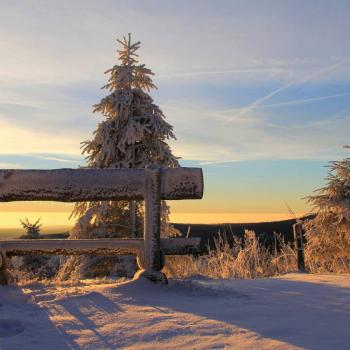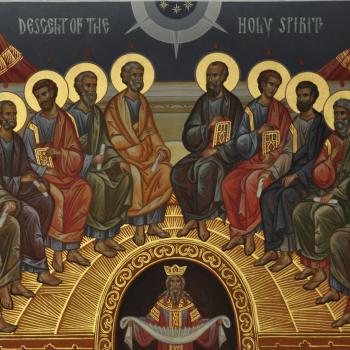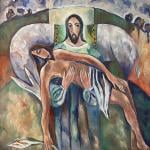The Adventurous Lectionary – Easter Sunday – April 17, 2022
Acts 10:34-43
Psalm 118:1-2, 14-24
I Corinthians 15:19-26
John 20:1-18 and Mark 16:1-12
Despite the celebrations that attend the resurrection of Jesus, Easter is a challenge for most preachers. Perhaps more so this year, as we return to in-person worship in most parts of North America. We want to celebrate. We want to give thanks for new possibilities. We want an extra special sermon. We want to say something new and life-transforming. We want to awaken our congregations to the unexpected resurrection event. We want to wake up to resurrection itself, despite our concerns about attendance and larger geopolitical issues. We know that Easter is incomprehensible, a miracle, beyond belief, or any sort of “objective” proof. And, yet the resurrection is at the heart of our faith and gave birth to the Jesus Movement. We can’t reduce it to logic, nor can we say we believe because it is unbelievable, or stifle questions and doubts.
We also recognize the theological challenges of resurrection, not just because of its miraculous nature, but because human nature hasn’t progressed too far since that first Easter. There is still genocide, acted out by supposedly rational leaders; a significant group in the USA nation has rallied around white nationalism, conspiracy theories, anti-science propaganda, and delusional politicians. Truth is in short supply while incivility reigns in the public square and on cable television.
How can we preach the resurrection to progressive Christians who don’t believe in unlawful intrusions by God in nature or in our own lives? And if we doubt the supernatural interpretations ourselves? How can we proclaim good news to someone trying on Christianity for the first time this Easter?
“This is the day that God has made, let us rejoice and be glad in it!” so proclaims the Psalmist. As I awaken each morning, this is my affirmation, one which carried me through the dark days of COVID. I am alive, grateful, and open to unheard of possibilities. What new and glorious thing will God do in this unrepeatable day. I am “woke” to wonder and love – to power I can’t control but can receive and transform to bring healing and beauty to the world. This affirmation gets me through the trials of environmental destruction and political abuses of power, empowering me to confront the evils I observe at home and abroad. Enabling me to see a way when there appeared to be only a dead end as I pondered the future.
This affirmation from Psalm 118 is the heart of the Easter proclamation – God has made this new day, this wonderful life-giving day, and rejoicing is the only appropriate response. Rejoice! The shroud of death no longer controls us, the future is open, and we are free to act boldly and lovingly. God is doing a new thing, the divine creativity brings forth new life with every new day, and that divine action creates life where death appeared triumphant. It may seem like a “idle tale” to sceptics, and to those who have given up on moral advancement, but to those who have experienced resurrection, this “tale” witnesses to life bursting forth in the face of death. This is nothing short of miraculous even to those who no longer believe in miracles! Or, who see them in purely rationalistic, mythical terms.
Although this year, the first in decades, I will be sitting in the sanctuary as a “retired” preacher, throughout my career, on Easter Sunday, my practice has been to read the passages from at least two gospels, always including the mysterious, short-form version of Mark. In all three gospels stories, women are at center stage and, for all intents and purposes, challenged to be the first messengers of the “great commission” to go and tell the world well before this message is given to Jesus’ male disciples. Though the women described in Mark’s Gospel are silent at first, I believe they eventually mustered the courage to tell the incredible story – the tomb is empty, and life begins again. The stone of anxiety and fear – of hopelessness – described by the women is rolled away and the future is full of promise once more.
The gospel accounts present two different perspectives on the resurrection, and they need not be harmonized, without glossing over their differences, much as we as we often do with the Christmas stories. In contrast to the approach of many Christians today, the early church was comfortable with diverse witnesses to Jesus’ birth and resurrection. The differing stories are not stumbling blocks to faith or veracity, but reminders that resurrection is ultimately indescribable. Neither Jesus nor his resurrection can be encompassed by our theologies and rituals. Jesus comes to us in the direst of situations and rolls away the stone of hopelessness. The future opens, life springs forth, even if it can be described rationally. How will Ukrainian refugees celebrate Easter this year? Or those mourning the loss of a loved one to COVID?
God is not “orthodox” – or limited to one understanding of revelation and inspiration – nor does God demand one path to our knowledge or experience of God’s presence in the world. We see in a mirror dimly, especially when it comes to the nativity and resurrection. Our words and worship point to the moon, to use a Zen Buddhist image, but are not the shining orb that guides our paths through life’s wilderness moments. This is especially true of resurrection which can never be fully understood by the rational mind or described by clear-cut dogmas to which we must assent.
Mark’s Gospel centers on the women’s witness. Three women come to the tomb. Perhaps, against the social mores of the time, these women traveled with Jesus, supporting his ministry and perhaps ministering to women in their patriarchal culture. The death of Jesus devastated them. Yet, though their world had collapsed, they like countless mourners before and after them came to give their beloved friend and teacher one last act of love, to anoint and embalm his lifeless body. They feel powerless as they look toward a future without him. They don’t even know if they can give this one last act of love, as they ask one another, “Who will roll away the stone for us?” But, to their astonishment, the stone has been rolled away, they tomb, and the angelic messenger reminds them of Jesus’ prophetic words and challenges them to live boldly, letting go of death and claiming resurrection life. Stunned, they don’t know what to do next. Resurrection needs to sink in before they can tell Jesus’ male disciples.
Jesus’ beloved and countercultural companion Mary Magdalene is a central figure in John’s Gospel as well. She apparently “comes to the garden alone,” discovers that the tomb is unoccupied and runs to Peter and John with an improbable tale – Jesus’ body has disappeared. She is unnerved by the empty tomb and returns to the garden – the verdant place of rebirth – grief-stricken, believing at first that Jesus’ body has been taken from the tomb, perhaps by the malevolent forces that nailed him to the cross. The grief she felt when her beloved friend died was unendurable and she needs closure. Like millions of bereaved persons, past and present, she needs to see the corpse as devastating: the sight of her beloved friend’s inert body will be to ground her in reality and help her move on, albeit in pain and hopelessness. She pleads with a “gardener” for answers. She wants to pay her respects, anoint his body, and show her love.
It is in this encounter with One Unknown that her life is transformed. The Risen Jesus calls her name, “Mary,” and her life is transformed. She comes back to life and though she can’t fathom the resurrection, and has no theology to understand it, she believes and worships. Resurrection is grounded in the constancy of God’s future impinging on the present; yet, it is something more, it is the radical leap beyond what we could ever imagine. There is a Deeper Magic, as C.S. Lewis says of the death and resurrection of Jesus, but this Magic Reality, embedded in the depths of creation is hidden from us until New Life bursts forth where death seemed victorious. When God calls us by name, we are born again. Could God be always calling us by name, but alas we are oblivious to it or have eliminate the mystical from our world views?
Mary of Magdala in her joy wants to hug the Risen One, but Jesus cautions her, “Don’t hold onto me.” Why not? We might ask. Why not an act of love and connection from the loving teacher to a beloved friend? Is Jesus’ body somehow quantum in nature, lifted to higher frequency, and now too energetic for human touch? Is he not fully reconstituted? Or is there something more at work here, something theological in nature? Could it be that Jesus is saying to Mary – and to us – “don’t hold onto static images of me, don’t localize me in space or time, or confine me to a particular spiritual body or institution”? Resurrection defies our attempts to control through institutional, intellectual, or ritual power. Yes, Jesus’ resurrected body is a “thin place” revealing heaven and earth. But, thin places are everywhere once we let go of our localizing of the resurrection and its power.
As I noted earlier, Jesus’ resurrection is not “orthodox” nor does it fit into any dogmatic statement. It is, like the Holy Spirit, a power that goes where it wills, unconfined by human conceptualities or authority systems. From now on, Jesus can’t be localized in Galilee or Jerusalem, he will be everywhere. From now on, Jesus can’t even be localized to the tradition that bears his name. He will bring wholeness to all creation and persons of all cultures.
In that same Easter spirit, Peter (as described in Acts) proclaims a global gospel and affirms that God shows no partiality among nations and cultures, and dare we say, churches and their clergy. The resurrection is not defined by our sacraments, or theologies, but is all-encompassing or nowhere at all. The resurrection is for all, salvation is for all. Thin places can be found everywhere! There are no resurrection-free zones or times, just as there are no Godless places, bereft of the omnipresent God. Nor can any institution claim to be the proprietor of resurrection power. Resurrection is as real now as it was in the first century. It still brings new life to lost and vulnerable, and alienated and grieving, humankind. You can’t build a wall to contain resurrection, whether theological, doctrinal, liturgical, or ecclesiastical. It is incorrigible in its universality.
Resurrection is the ultimate antidote to death in all its faces, from bigotry and xenophobia to physical annihilation. Resurrection plays no favorites. Although I am no biblical literalist, for a moment I will play the literalist game, asking those who restrict resurrection to a favored few believers, what is it about “for as all died in Adam, all will be made alive in Christ” that you don’t understand? “All” means “all” not part or predestined or believers, but “all.” At the very least, resurrection touches us all, providing a pathway from death to life for everyone, even those who are afar off as a result of their doubts, behavior, or religious tradition. As Paul says elsewhere, God will be “all in all.”
Today, we can open to resurrection power, and let it flow through us to all creation. Though beyond our control and untrammeled by our belief systems, we can awaken to resurrection in all the dead zones of life, trusting that God will revive us all, and trusting that we are to be agents of resurrection, bringing forth life in death-full situations in our time. We can “practice resurrection,” as Wendell Berry says, and speak for life in contrast to the culture of death, genocide, and prevarication that confronts us.
+++
Bruce Epperly is a pastor, professor, and author of over sixty books, including “Talking Politics with Jesus: A Process Perspective on the Sermon on the Mount,” “Mystics in Action: Twelve Saints for Today,” “Walking with Francis of Assisi: From Privilege to Activism,” “Angels, Mysteries, and Miracles: A Progressive Vision,” and “Prophetic Healing: Howard Thurman’s Vision of Contemplative Activism.” He may be reached at [email protected]












